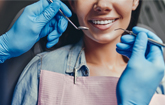Penn Dental-led Team Uses Nanoparticles to Break Up Plaque and Prevent Cavities
PHILADELPHIA, Aug. 23, 2016 /PRNewswire-USNewswire/ -- The bacteria in dental plaque that contribute to tooth decay often resist traditional antimicrobial treatment, as they can "hide" within a sticky biofilm matrix, a glue-like molecular scaffold.
A new strategy conceived by Penn Dental Medicine-led researchers took a more sophisticated approach to fighting the bacteria. Instead of simply applying an antimicrobial, they used the pH-sensitive and enzyme-like properties of iron-containing nanoparticles to catalyze the activity of hydrogen peroxide, a common natural antiseptic. The activated hydrogen peroxide produced free radicals that simultaneously degraded the biofilm matrix and killed the bacteria within, significantly reducing plaque and preventing tooth decay in an animal model.
"Even using a very low concentration of hydrogen peroxide, the process was incredibly effective at disrupting the biofilm," said Hyun (Michel) Koo, professor in Penn Dental Medicine's Department of Orthodontics and divisions of Pediatric Dentistry and Community Oral Health and senior author of the study, published in Biomaterials. "Adding nanoparticles increased the efficiency of bacterial killing more than 5,000-fold."
The paper's lead author was Lizeng Gao, a researcher in Koo's lab. Collaborating on the project was David Cormode of Penn's Perelman School of Medicine and School of Engineering and Applied Science, who helped to synthesize, characterize and test the effectiveness of the nanoparticles. The work built off a seminal finding by Gao and colleagues, published in 2007 in Nature Nanotechnology, showing that nanoparticles, long believed to be biologically and chemically inert, could possess enzyme-like properties and that this activity is dependent on pH.
Gao had found that the nanoparticles had no catalytic activity at neutral/near-neutral pH. But when pH was acidic, they become highly active and can rapidly produce free radicals. The scenario was ideal for targeting plaque, which can produce an acidic microenvironment when exposed to sugars.
Beginning with in vitro studies and then moving to an animal model, they applied the nanoparticles and hydrogen peroxide topically to the teeth of rats, which can develop tooth decay as humans do when infected with the cavity-causing bacteria Streptococcus mutans. Twice-a-day, one-minute treatments for three weeks significantly reduced the onset and severity of decay compared to the control or treatment with hydrogen peroxide alone. No adverse effects to the oral soft tissues were observed.
"It's very promising," said Koo. "The efficacy and toxicity need to be validated in clinical studies, but I think the potential is there."
SOURCE Penn Dental Medicine
Related Links
WANT YOUR COMPANY'S NEWS FEATURED ON PRNEWSWIRE.COM?
Newsrooms &
Influencers
Digital Media
Outlets
Journalists
Opted In





Share this article